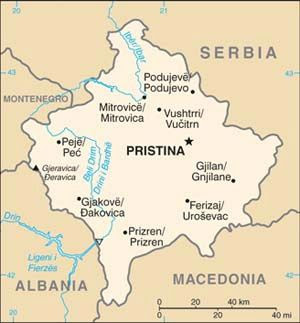Kosovo: Pristina-Belgrade Agreement Changes Everything Too – Analysis
Whilst the referendum and footnote agreement have fundamentally altered the dynamics of the Kosovo issue, the outcomes for the north remain what they have always been, making it prudent to start thinking about acceptable alternatives.
By Gerard M. Gallucci
Under Quint pressures on both sides, Belgrade and Pristina agreed last week on a formula under which Kosovo will be able to participate on its own in regional organizations. Kosovo will sit at the table as any independent state would, with only a footnote to provide Belgrade diplomatic coverage. This places Kosovo firmly on the road to increased international recognition and will gain Serbia some form of EU candidacy. It also effectively narrows the outstanding issues concerning Kosovo status to the question of the north.

The agreement reached in Brussels on February 24th provides for Kosovo to be seated in regional organizations as “Kosovo*.” The *footnote reads: “This designation is without prejudice to positions on status, and is in line with UNSC 1244 and the ICJ Opinion on the Kosovo declaration of independence.” Kosovo will not be referred to as a “Republic” – and this has stirred the opposition to the Thaci government – but will participate and speak for itself on “its own account.” Where UNMIK also has participated on behalf of Kosovo, the UN will decide whether to appear as well or not. (It would be out of character for the UN to remain in such a role when all parties have agreed on an alternate approach.) This new status will also make it possible for the EU to move ahead and formalize its relationship with Pristina.
Thus begins the next phase of Kosovo independence. The asterisk is a fig leaf that preserves Serbia’s legal position while giving away the practical reality. As Kosovo moves into representing itself as an independent state, it will without doubt gain further recognitions as hold-outs wonder why they should be more stringent than Serbia. However long it takes, Belgrade’s position will become the minority one.
Pristina acted quickly to begin consolidating its new position by arresting some Serbian police living and perhaps working in southern Kosovo. The methods used may have been harsh and it is good that EULEX has taken over the case to ensure due process. It is natural, however, that the Pristina government will increasingly exercise its authority in the areas of Kosovo where it can. The chief challenge for Pristina will be to move forward in measured ways without seeking to pre-empt political solutions to remaining issues through use of force.
The outstanding remaining issue is, of course, the north. As Kosovo is now clearly moving forward as an independent state, the north has shown in its recent referendum and its continued resistance to imposition of Pristina institutions that it wants no part of that independence.
The EU appears to be ready to grant Serbia candidacy but without a date. (A date is important because it is only with that that the money flows.) This would reward Serbia’s president, Boris Tadić, while preserving leverage on Belgrade no matter who wins the upcoming elections. (The EU would almost certainly not want to give Serbia a date and then have Nikolić win anyway.) So Quint pressure on Belgrade to make core concessions on the north is probably in the cards for the second half of this year.
Barring any further unilateral acts by Pristina in the north, the Quint and their agents – KFOR and EULEX – may not push their agenda there until after the elections. With the help of the Serbian police, they have “opened” the boundary crossings. EULEX has also put the north Mitrovica court on the table. It’s possible that some deal has been struck for Tadić to take further steps to cut off the north – cancel local elections there, make or allow arrests of northern leaders – but seeking to implement such decisions in the next two months could undo with the Serbian electorate any positive effect of EU candidacy.
Even after the elections, it would not be easy to overcome northern resistance to Pristina. A renewed Democratic Party (DS) led government, however, with five more years ahead of itself could decide to cut funding for the “rebellious” north, put the municipalities under administration and approve EULEX efforts to introduce a court and fully implement customs in the north. (On the 24th, the two sides also agreed to the technical details of their integrated management of the northern crossings.) This could set the stage for another effort by Pristina and friends to push into the north. This remains a formula for further ethnic conflict and/or flight. The Quint, however, has grown impatient.
So, while the referendum and footnote agreement have fundamentally altered the dynamics of the Kosovo issue, the outcomes for the north remain what they have always been: continued frozen conflict, conflict leading to violence and partition or exodus, or agreement on some form of special autonomy for the north perhaps along the lines of a status-neutral approach to the Ahtisaari Plan. While some in the north may bank on their ability to withstand the pressures and would be satisfied with continued stalemate, it would also be prudent to start thinking of acceptable alternatives.
Gerard M. Gallucci is a retired US diplomat and UN peacekeeper. He worked as part of US efforts to resolve the conflicts in Angola, South Africa and Sudan and as Director for Inter-American Affairs at the National Security Council. He served as UN Regional Representative in Mitrovica, Kosovo from July 2005 until October 2008 and as Chief of Staff for the UN mission in East Timor from November 2008 until June 2010. Gerard is also a member of TransConflict’s Advisory Board.
